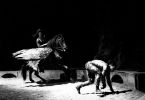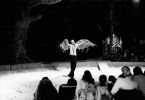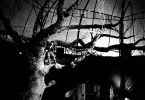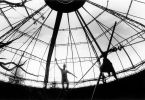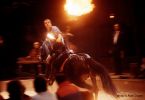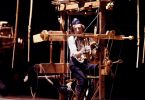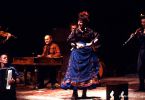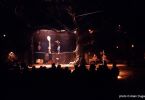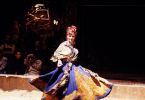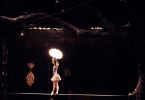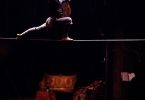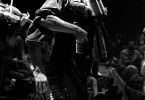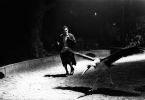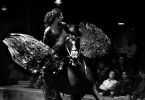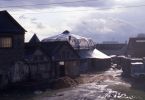La Volière (The Aviary)
Creation 1990/1994
 Produced by:
Produced by:Théâtre de Vidy – Lausanne (Switzerland) / Directed by Mathias Langhoff
Théâtre National de Bretagne – Rennes / Directed by Emmanuel De Véricourt
Le Volcan, scène nationale – Le Havre
Also supported by the Ministry of Culture and the French-speaking community, and the Ministry of Foreign Affaires, AFAA / The French Association of Artistic Action.
La Volière is a big top circus tent, with a transparent dome, but it's more than a big top. By way of gypsy music that reunites 240 birds, horses, and other animals, along with about 15 artists that come from the world of theater, music, and the circus, it sets the scenery for the colorful performance.
Two versions were created between 1990 and 1994 “Dernier chant avant l’envol” (The last song before takeoff) and “Vertiges” (Dizziness).
These plays were performed for a long period of time; 353 times in France and in Europe; Lausanne (Switzerland), Bordeaux, Nîmes, Rennes, Strasbourg, Marne la Vallée, Paris, Saint Herblain, Lisbon (Portugal), Hainburg (Austria), Le Havre, Cherbourg, Toulouse, Brest Villeurbanne, Avignon, Esslingen (Germany) Zurich (Switzerland)
“Dernier Chant avant l’envol” (The last song before takeoff)
First performed 1990-1991
First version
A winged horse, a butler with a long beak, musicians that chatter, a double bass that’s really a tree, the trills escaping from a cage that’s really a woman, seven crows discussing endlessly in shadowy light reflecting like copper…
The daze provoked within these walls by the arrival of this crazy crew is tremendous. Them, the hair-brained crew of Dromesko say, of course, that up until this point, the birds had one up on us. That they looked upon our pitiful strides, from high up, making us beg for mercy from their feints. But today, the time has come to abandon the sweet comfort of our dream-state to strike back. They say that the round hasn’t been played, and that the snickering of the mocking Azure-Winged Magpie, from the Himalayas, won’t resound any longer under their big aviary placed somewhere between the earth, and the sky. Far from putting the burden on these winged creatures of an approaching chastising, the Dromesko crew spoils them… so that they fly better. He, that didn’t see the crow turn pale in front of the delicate lightness of the tight-rope walker, will never know the lasting shivers bringing us close to the euphoria in which we float, gliding along in a sapphire sky of unthinkable pleasures, removed from the power of gravity. DROMESKO, the last song before takeoff.
“Vertiges” (Dizziness)
First performed 1992-1993
Second Version
“From the angel’s view, maybe the tree-tops are the roots, drinking from the skies, and in the ground, the deep roots of a beech tree seem to them as quiet rooftops.”
Rainer Maria Rilke
“Tonight, above you …
The wings that you don’t have, or no-longer have.
From our lost wingspan, from our amputated graces, remain souvenirs of tormenting doubt or of nostalgia.
Were we birds once, somewhere else? Are the arabesques that we traced in the sky, at some other time, the same that some of us miserably attempted to recreate on paper, on canvas, in the musical score, or as the scene? What sinful prides have we, to be so condemned? Legs glued to the earth, thoughts aimed at reason; always having a desire to understand; like unavailing laborers, forced to endlessly rebuild the foundations of meaning. What have we won from he who asks the questions, in exchange for this unique, grisly liberty? If in initiating his show Vertiges, and inviting us to the takeoff of hi-flyers, Dromesko wanted to prove to us, without a shadow of a doubt, of our unsupportable weight, and our incurable rationalism lurking in the crevices of our brains, then he succeeded from the start.
If, and furthermore, he wanted to scratch at this idea, one that always hurts a bit, at the root of our wildest fantasies, he couldn’t have chosen a better method than to reunite us, flyers and non-flyers all in the same cage, with the smells of a wet ground and impossible dreams; the firsts; with their beaks in the stars and their noses in the stars’ gravitational pull.
If it were a lesson, actually, that Igor, the director of the aviary, would accept that the birds give us, then it’s most certainly the lighter one. Lightness is his obsession, as it is for the world; a lightness belonging to all who are trainers of words, colors, shapes, horses, and images. A lightness that they have worked for, that they chained themselves together for, and sweated like convicts for; just until the ball and chain of work seemed as light as a child’s balloon. Every one of them created ridiculous poetic or realistic, or gliding or backfiring machines – always too heavy in their eyes – to take flight, to go and touch the sun, or at least experience the gracefulness of the flight that leads there.
Dromkeso’s Aviary (La Volière) doesn’t escape the rules; we think that he is ready to fly away; made of feathers, see-through, and of dreams; when seven tons of wrought iron make up it’s armor and thousands of kilometers of mistakes and of know-how of every kind make up his company.
Some of them, rare, less attached, have the memory of being a bit lighter than air, or have kept in their memory a few scraps of their past avian life. They serve as smugglers to us: a violinist, a knight or a rider, a tightrope walker… They are, as such, brothers in their lightness, or the less humbled students of every bird, of every feather, from all corners of the globe, sharing the stage.
But we don’t fly straight; there are some that keep their fleeting feelings of liberty, and us, with our questions. Each specie has it’s own way of getting it. Of course, it could have happened – but haven’t we already heard the confirmation? – That a by-stander, in good graces, in an attic fair and light, rejoins the birds in the place of performance. But for all of these Icares, the Birdies won’t change a thing; we will never be the agents of “the song of creation”, as Saint John Perse writes it. Fairness is taken care of by the birds. Who has ever actually seen an error in the harmony of their passage? Who has ever seen a bird fly wrong…?
So there you have it. We are here again with our pathetic barrage of questions: Who? Where? When? Why? If we wanted, at all costs, to think about it, then let’s go back rather to the questions being asked: What are we to the birds? How do they see us? Who do they think they are? These craniums with two feet so pronounced that they draw feverish trajectories high above even themselves, without reason. Maybe they see themselves as the last dinosaurs.”
Claude-Henri Buffard, Newspaper of the Théâtre National Populaire, June 1994.
